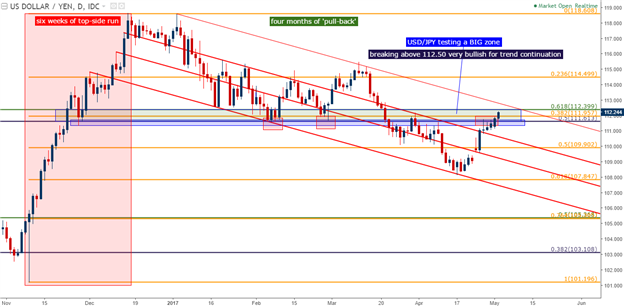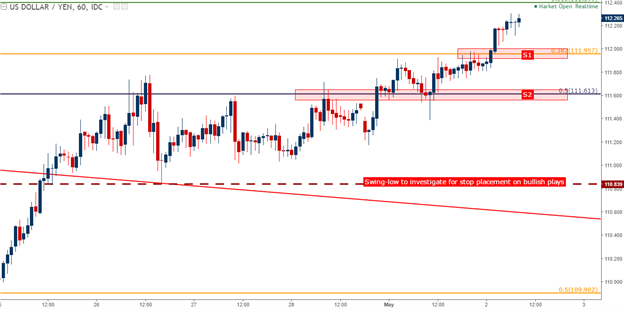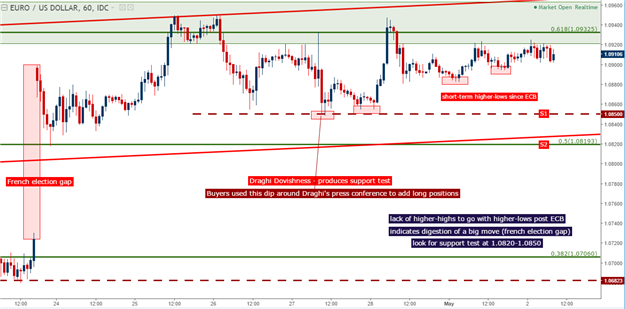Talking Points:
- Tomorrow brings the Federal Reserve’s rate decision for the month of May, and Friday brings Non-Farm Payrolls for the month of April.
- The one certainty here is that the Dollar will probably put in some movement, and below we look at both bullish and bearish scenarios for USD.
- If you’re looking for trading ideas, check out our Trading Guides. And if you’re looking for ideas that are more short-term in nature, please check out our IG Client Sentiment Indicator.
To receive James Stanley’s analysis directly via email, please SIGN UP HERE
The remainder of this week will be pivotal for near-term price action in the U.S. Dollar. Tomorrow brings us the Federal Reserve’s rate decision for the month of May, and on Friday we get Non-Farm Payrolls for the month of April. Each of these drivers can produce impact on the U.S. Dollar, and given the Greenback’s bifurcated run of recent, showing weakness against the British Pound and the Euro while showing strength against the Japanese Yen, and traders may have some interesting opportunities for trading swings into new trends over the next couple of days. Below, we look at a bullish and a bearish scenario around the Greenback as we trade into the latter portion of this week.
Long USD/JPY – Optimal for Bullish-USD Scenarios
One of the more pervasive moves in the FX-world over the past couple of weeks has been a re-ignition of Yen weakness. And for FX traders, this is likely a welcome occurrence as trading Yen weakness has become an attractive theme for trend, momentum and swing traders since the election of Shinzo Abe in Q4 of 2012. But it hasn’t been all smooth sailing for the Yen since 2012, as numerous periods of risk aversion have seen the Yen re-strengthen, tempering gains in pairs like USD/JPY, EUR/JPY and GBP/JPY.
After the U.S. Presidential election ushered in the ‘reflation trade’, the Yen caught a significant run of weakness as the risk trade went ballistic. Stock prices around-the-world jumped-higher, and the world’s favored funding currency (the Yen) put in a significant bout of six weeks’ worth of weakness. After trading below 102.00 on the night of the election, USD/JPY had jumped to as high as 118.60 just six weeks later, right before the Federal Reserve hiked rates in December.
But since that December rate hike, matters haven’t really been the same. USD/JPY set that high at 118.60 and that level was re-tested just a couple of weeks later, shortly after the open of the New Year. But after that, weakness took over as the pair spent much of the next four months channeling lower; wiping away approximately ~60% of that prior election-inspired move.
Since mid-April, Yen-weakness has begun to take hold as a prominent theme across FX-land, again; with the Yen putting in significant moves against most major currencies. Below, we look at the current setup in USD/JPY with price action moving into and testing a key zone of resistance.

Chart prepared by James Stanley
The initial move after the election took about six weeks. The corresponding pull-back has taken four months; and if price action can break above 112.50, there would be a number of bullish factors denoting the possibility of further top-side continuation in USD/JPY. With a Federal Reserve meeting on the docket for tomorrow, there’s a very likely driver that can produce some volatility here.
Within this zone of resistance on USD/JPY are a number of levels that can be used for shorter-term analysis. On the hourly chart below, we’re looking at the stair-step of ‘higher-highs’ and ‘higher-lows’ in the pair. Pullbacks to either 111.96 or 111.61 could open the door to bullish trend plays, with the prior swing-low around 110.84 as a basis for stop placement.

Chart prepared by James Stanley
Long EUR/USD – Optimal for Bearish-USD Scenarios
Last week brought a pivotal European Central Bank meeting to markets. With the European QE program turning two years old in March, we’ve finally begun to see some evidence of recovery. Investors had begun to prognosticate that once the ECB’s current program expires in December of this year, they might not need to enact more. So when we came into last week’s press conference after the ECB announced no changes to rates, this was the key question burning on market participants’ minds: When will the ECB end QE?
Mr. Mario Draghi successfully tap-danced around this, saying that there was no discussion on exit strategy and that the bank would be sticking with their stimulus program until it was no longer needed. But if you watched EUR/USD, you probably would’ve noticed that Draghi’s denials did little to temper EUR/USD price action.
EUR/USD has been running-higher for much of 2017, building into a fairly consistent bullish trend-channel. After French elections two weeks ago, EUR/USD gapped-up to the resistance side of that channel, and then ran into a key Fibonacci level at 1.0933. Since then, the pair has bounced back-and-forth between 1.0850-1.0933; and this includes Draghi’s dovishness at last week’s ECB meeting, which merely produced another test of support.

Chart prepared by James Stanley
By going down to the hourly chart, we can focus-in on price action after that gap from two weeks ago. And notice on the hourly chart, how slightly ‘higher-lows’ are building-in while resistance remains respected. This can be dangerous, as these slightly higher-lows on the lower time frame may lull traders into a false sense of security around increasing bullishness. More proactively, traders can wait for a support test around the 1.0850 level, or perhaps even as deep as 1.0820 before looking at top-side continuation of the ‘bigger picture’ trend in EUR/USD.

Chart prepared by James Stanley
--- Written by James Stanley, Strategist for DailyFX.com
To receive James Stanley’s analysis directly via email, please SIGN UP HERE
Contact and follow James on Twitter: @JStanleyFX






